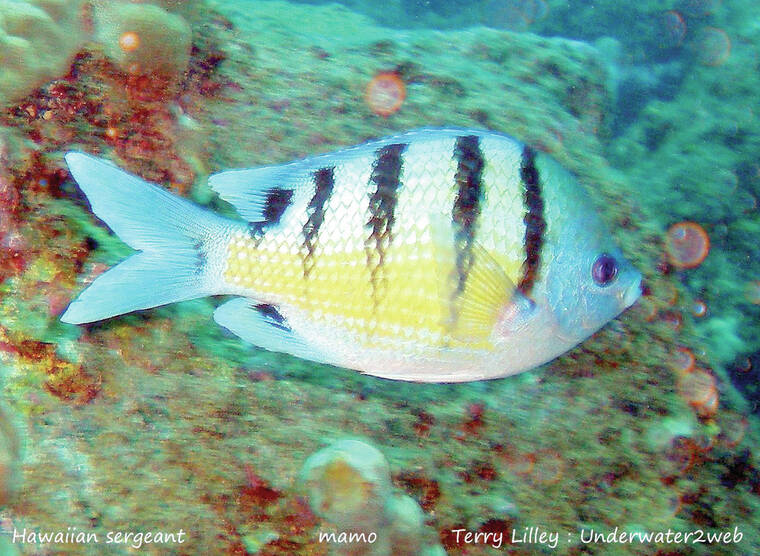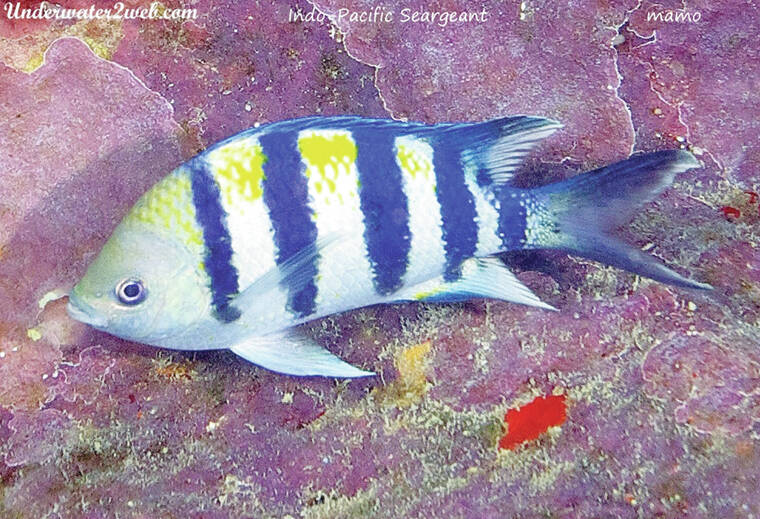Most scuba divers and snorkelers have seen this common, six-inch-long Hawaiian fish, but few people know that the male mamo does not like divers! The Hawaiian sergeant females lay thousands of purple eggs on the flat surface of rocks out on the reef, and the male protects the eggs from predators.
Most scuba divers and snorkelers have seen this common, six-inch-long Hawaiian fish, but few people know that the male mamo does not like divers! The Hawaiian sergeant females lay thousands of purple eggs on the flat surface of rocks out on the reef, and the male protects the eggs from predators.
While diving in shallow, calm water, we often see 50 to 100 large purple patches of eggs on the reef being fiercely protected by the male sergeant fish. Most of the reef fish love to eat mamo eggs, but the male protecting the eggs will dart back and forth, chasing off even the most-aggressive reef fish until a scuba diver comes by.
Scuba divers, large sharks and monk seals are no match for the six-inch-long male mamo, and when we get close to the eggs we scare off the protecting male. Schools of butterfly-fish will sometimes follow a scuba diver just waiting for the male mamo to leave the eggs unguarded and then they will zoom in and gobble up the eggs until the diver passes by and the male mamo comes back to chase off the school of butterfly-fish Sometimes divers will be followed around by large schools of butterfly-fish not knowing why they are being followed. For several weeks the male mamo will spend its entire day trying to protect the females eggs, of which over 90% of the eggs will still get eaten by other fish by the time they hatch.
Mamo eggs are a very-important part of the food chain out on a healthy Hawaiian coral reef.
We have two types of sergeants in Hawai‘i, and they are in the damsel-fish family. The Hawaiian sergeant, which is gray with dark stripes, and the Indo-Pacific sergeant, have the same pattern, but bright yellow sides.
Both species live together, and they get their name from their stripes that look like the stripes of a British sergeant in the military. The sergeant fish is one of the most-common fish worldwide in tropical waters, and once their purple eggs hatch, their babies float in surface currents, often for hundreds of miles, blown by the wind. In old Hawai‘i there was only one species of Hawaiian sergeant, but in recent times the Indo-Pacific mamo showed up and was probably blown over to Hawai‘i from a different Pacific island.
You can see mamo in action up on my underwater educational web page at www.underwater2web.com in my movie “The World’s Guide To Hawaiian Reef Fish.”
•••
Terry Lilley is a marine biologist living in Hanalei and co-founder of Reef Guardians Hawai‘i, a nonprofit on a mission to provide education and resources to protect the coral reef. To donate to Reef Guardians Hawai‘i go to www.reefguardianshawaii.org.






